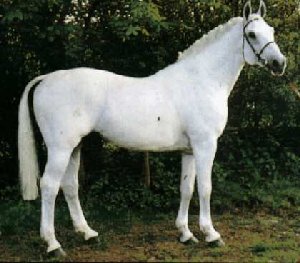

Since 1958, the French warmblood has been called le cheval de Selle Francais (French Saddle Horse). Like all warmbloods, it is a mix of breeds, but it owes much to fast trotting blood.
In the ninteenth century, the skillful Normandy breeders imported English Thoroughbred stallions and half bred stallions to cross with their tough but common Norman stock. Most of those half-bred stallions had a background of robust Norfolk Roadster. They produced two crossbreds, the fast harness horse and the Anglo-Norman, which was subdivided into a riding horse and a draft cob. The former was the prototype for the Selle Francais.
After the Second World War, the production of a riding horse possessing speed, stamina and ability was accelerated. Trotter, Thoroughbred and Arabians have all contributed to the development of the type. It is primarily a show jumper, but it is also bred to race. Many also participate in cross-country racing and eventing.
Of the existing breeds, 33% are by Thoroughbred sires, 20% by Anglo-Arabs, 2% by French Trotters and 45% by Selle Francais stallions, some of whom have trotting connections.
The height of the Selle Francais is broken down into two categories, Mediumweight and Heavyweight. Mediumweight: Small to 15.3hh; Medium 15.3-16.1hh; Large over 16.1hh. Heavyweight: Small below 16hh; Large over 16hh. The head has lost the coarseness of it's Norman predecessors. This increased refinement has come from the Thoroughbred and Arabian influence. Despite increased quality, the head remains reminiscent of the French Trotter. There is no fleshiness in the jowl. A long, elegant neck, more graceful than that of the French Trotter, is typical of the breed. Early Anglo-Normans, particularly those close to the Trotters were inclined to straightness in the shoulder, a failing that has been rectified in the Selle Francais. The breed should have a very good bone measurement, no less than 8". The old fault of small knees in the breed has been eliminated. The outline is generally that of the Thoroughbred, but there are unmistakable overtones of the more rawboned Trotter in the body and limbs. The quarters are broad and very suited to the purpose of show jumping. The trotting connection has passed on limbs of exceptional strength with the especially powerful forearms that are a feature of both the riding and trotting horses. The joints must be clean, well developed and correct. The movement is active, long-striding and characterized by a supple agility. The jumping ability is pronounced and the breed has more spirit than many other warmbloods. All colors are permissible in the Selle Francais but chestnuts are the most common.
Reference: The Ultimate Horse Book; Elwyn Hartley Edwards; 1991


Reference photo courtesy of Equiweb
Background photo courtesy of Especes
